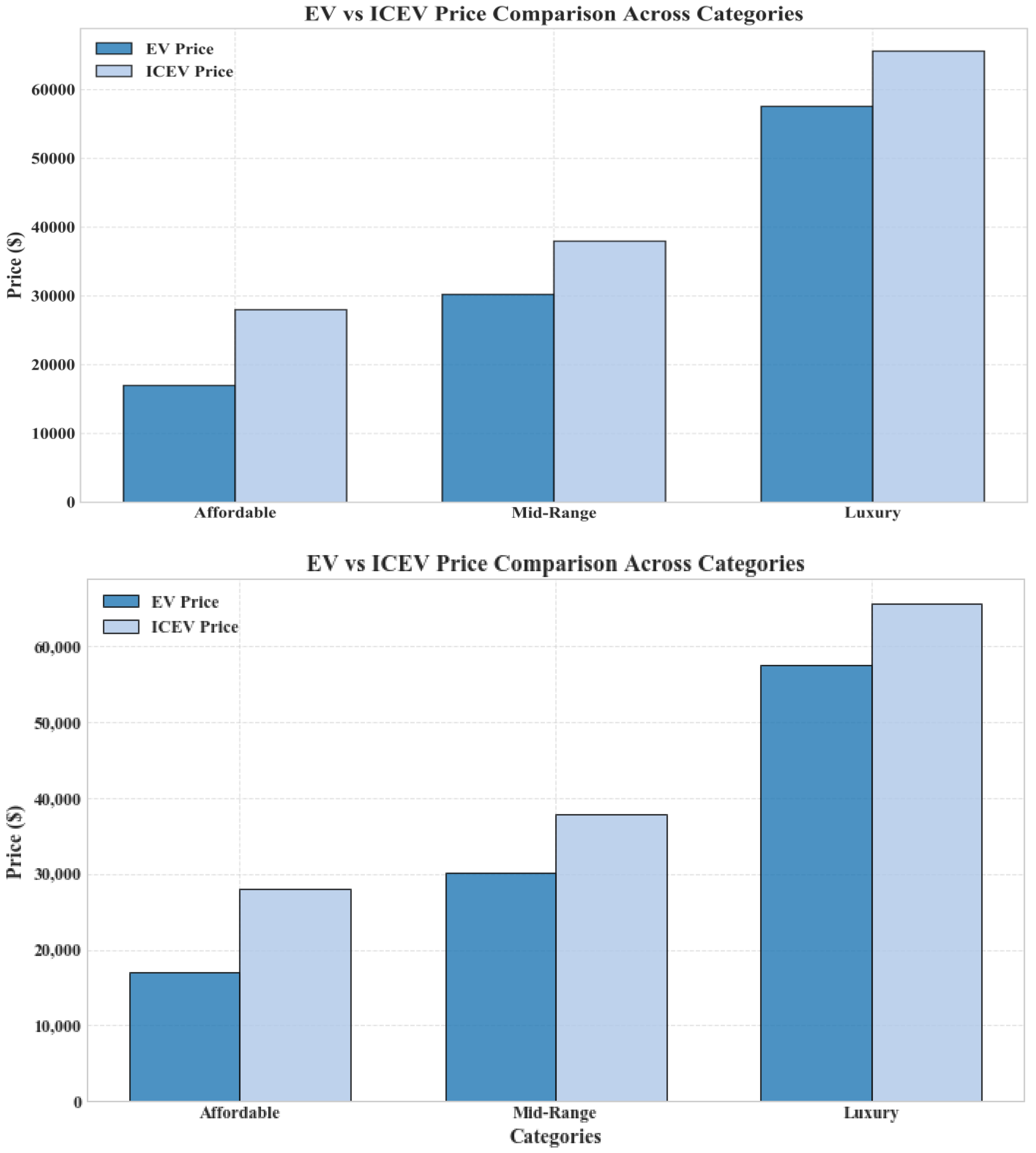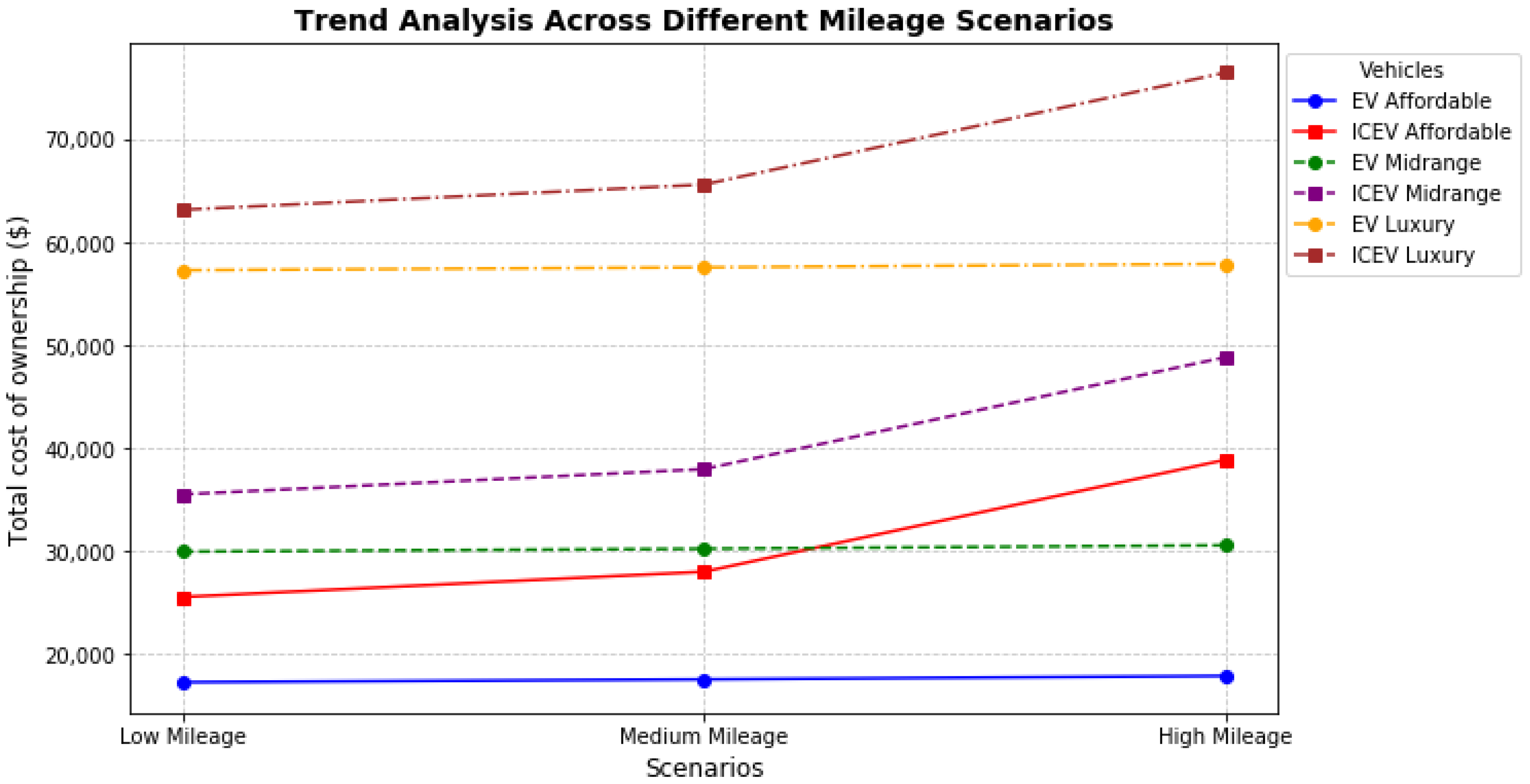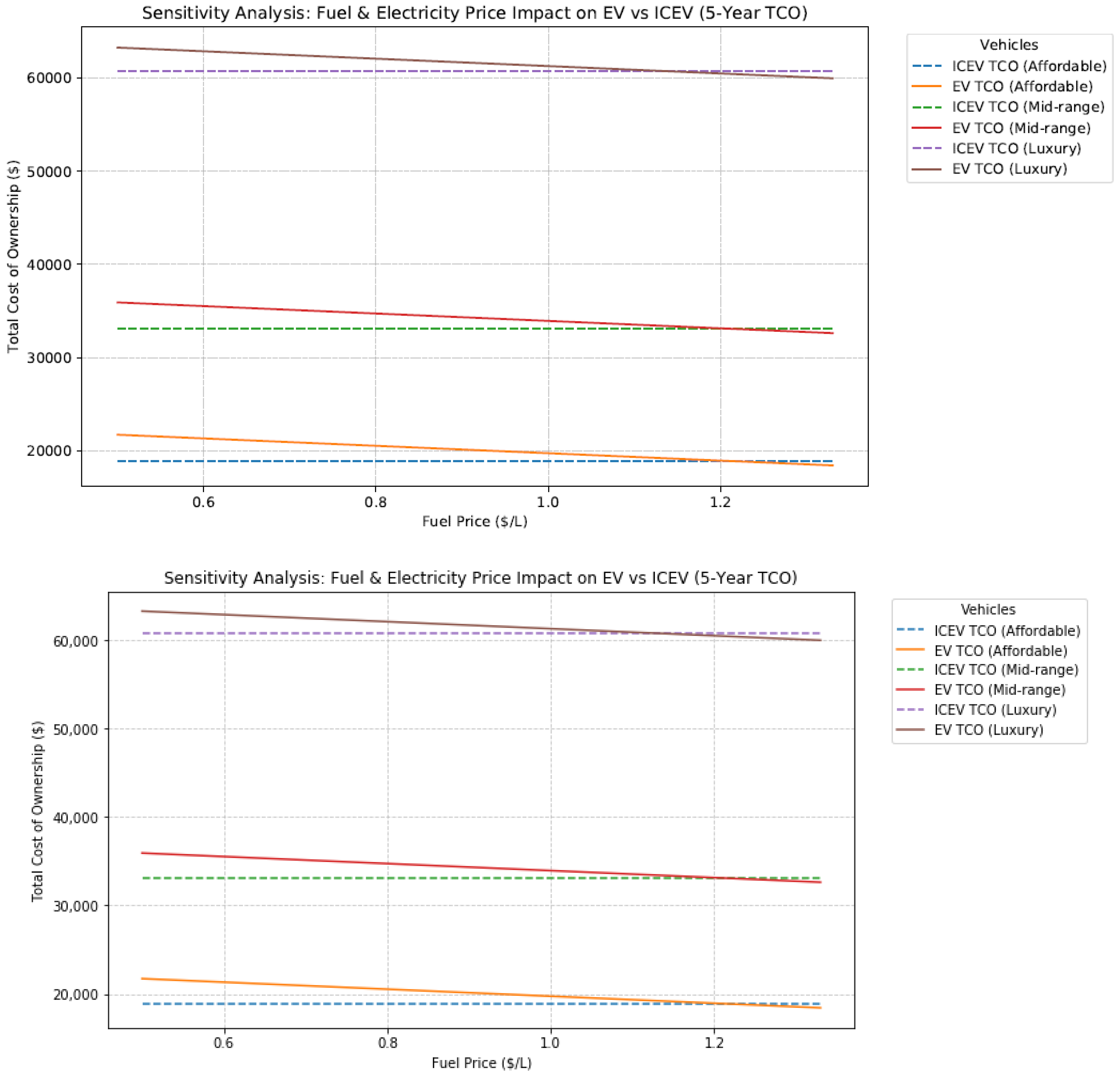Toward Sustainability: The Role of Tax Policies in Enhancing the Cost-Competitiveness of Electric Vehicles in Jordan
Abstract
1. Introduction
2. Literature Review
3. Overview of the Status of Electric Vehicles in Jordan
4. Materials and Methods
4.1. Initial Costs, Taxes and Government Incentives
4.2. Fuel Costs
4.3. Maintenance Cost
4.4. Insurance Cost
5. Results
5.1. Sensitivity Analysis
5.2. Annual Mileage
5.3. Fuel Prices
6. Conclusions
Author Contributions
Funding
Institutional Review Board Statement
Informed Consent Statement
Data Availability Statement
Conflicts of Interest
References
- Yong, J.Y.; Ramachandaramurthy, V.K.; Tan, K.M.; Mithulananthan, N. A review on the state-of-the-art technologies of electric vehicle, its impacts and prospects. Renew. Sustain. Energy Rev. 2015, 49, 365–385. [Google Scholar] [CrossRef]
- Tie, S.F.; Tan, C.W. A review of energy sources and energy management system in electric vehicles. Renew. Sustain. Energy Rev. 2013, 20, 82–102. [Google Scholar] [CrossRef]
- Kabatepe, B.; Türkay, M. A bi-criteria optimization model to analyze the impacts of electric vehicles on costs and emissions. Comput. Chem. Eng. 2017, 102, 156–168. [Google Scholar] [CrossRef]
- Lindly, J.K.; Haskew, T.A. Impact of electric vehicles on electric power generation and global environmental change. Adv. Environ. Res. 2002, 6, 291–302. [Google Scholar] [CrossRef]
- Reddy, V.J.; Hariram, N.P.; Maity, R.; Ghazali, M.F.; Kumarasamy, S. Sustainable vehicles for decarbonizing the transport sector: A comparison of biofuel, electric, fuel cell and solar-powered vehicles. World Electr. Veh. J. 2024, 15, 202. [Google Scholar] [CrossRef]
- IEA. Global EV. Outlook, Licence: CC BY 4.0. 2024. Available online: https://www.iea.org/reports/global-ev-outlook-2024 (accessed on 2 September 2024).
- Muratori, M.; Alexander, M.; Arent, D.; Bazilian, M.; Cazzola, P.; Dede, E.M.; Farrell, J.; Gearhart, C.; Greene, D.; Jenn, A.; et al. The rise of electric vehicles—2020 status and future expectations. Prog. Energy 2021, 3, 22002. [Google Scholar] [CrossRef]
- Rietmann, N.; Hügler, B.; Lieven, T. Forecasting the trajectory of electric vehicle sales and the consequences for worldwide CO2 emissions. J. Clean. Prod. 2020, 261, 121038. [Google Scholar] [CrossRef]
- Khaleel, M.; Nassar, Y.; El-Khozondar, H.J.; Elmnifi, M.; Rajab, Z.; Yaghoubi, E.; Yaghoubi, E. Electric vehicles in China, Europe, and the United States: Current trend and market comparison. Int. J. Electr. Eng. Sustain. 2024, 2, 1–20. [Google Scholar]
- Egbue, O.; Long, S. Barriers to widespread adoption of electric vehicles: An analysis of consumer attitudes and perceptions. Energy Policy 2012, 48, 717–729. [Google Scholar] [CrossRef]
- Shalalfeh, L.; AlShalalfeh, A.; Alkaradsheh, K.; Alhamarneh, M.; Bashaireh, A. Electric vehicles in Jordan: Challenges and limitations. Sustainability 2021, 13, 3199. [Google Scholar] [CrossRef]
- Martens, B.; Walterbusch, M.; Teuteberg, F. Costing of cloud computing services: A total cost of ownership approach. In Proceedings of the 2012 45th Hawaii International Conference on System Sciences, Maui, HI, USA, 4–7 January 2012; pp. 1563–1572. [Google Scholar]
- Strebel, J.; Stage, A. An Economic Decision Model for Business Software Application Deployment on Hybrid Cloud Environments; Multikonferenz Wirtschaftsinformatik: Göttingen, Germany, 2010; p. 47. [Google Scholar]
- Qiaoyi, L.; Lee, L. China Unveils $72 Billion Tax Break for EVs, Other Green Cars to Spur Demand. 2023. Available online: https://reuters-reuters-prod.cdn.arcpublishing.com/business/autos-transportation/china-announces-extension-purchase-tax-break-nevs-until-2027-2023-06-21/ (accessed on 20 May 2025).
- Patil, G.; Pode, G.; Diouf, B.; Pode, R. Sustainable Decarbonization of Road Transport: Policies, Current Status, and Challenges of Electric Vehicles. Sustainability 2024, 16, 8058. [Google Scholar] [CrossRef]
- Tutu, A. EV Incentives in 2024: Europe, the US and China. 2024. Available online: https://www.carvibz.com/news/ev-incentives-in-2024-europe-the-us-and-china/ (accessed on 20 May 2025).
- Woody, M.; Adderly, S.A.; Bohra, R.; Keoleian, G.A. Electric and gasoline vehicle total cost of ownership across US cities. J. Ind. Ecol. 2024, 28, 194–215. [Google Scholar] [CrossRef]
- Alshamaila, Y.; Papagiannidis, S.; Alsawalqah, H. Smart cities in Jordan: Challenges and barriers. Cities 2024, 154, 105327. [Google Scholar] [CrossRef]
- Liu, Z.; Song, J.; Kubal, J.; Susarla, N.; Knehr, K.W.; Islam, E.; Nelson, P.; Ahmed, S. Comparing total cost of ownership of battery electric vehicles and internal combustion engine vehicles. Energy Policy 2021, 158, 112564. [Google Scholar] [CrossRef]
- Hagman, J.; Ritzén, S.; Stier, J.J.; Susilo, Y. Total cost of ownership and its potential implications for battery electric vehicle diffusion. Res. Transp. Bus. Manag. 2016, 18, 11–17. [Google Scholar] [CrossRef]
- Desreveaux, A.; Hittinger, E.; Bouscayrol, A.; Castex, E.; Sirbu, G.M. Techno-economic comparison of total cost of ownership of electric and diesel vehicles. IEEE Access 2020, 8, 195752–195762. [Google Scholar] [CrossRef]
- Franzò, S.; Nasca, A.; Chiesa, V. Factors affecting cost competitiveness of electric vehicles against alternative powertrains: A total cost of ownership-based assessment in the Italian market. J. Clean. Prod. 2022, 363, 132559. [Google Scholar] [CrossRef]
- Wu, G.; Inderbitzin, A.; Bening, C. Total cost of ownership of electric vehicles compared to conventional vehicles: A probabilistic analysis and projection across market segments. Energy Policy 2015, 80, 196–214. [Google Scholar] [CrossRef]
- Letmathe, P.; Suares, M. A consumer-oriented total cost of ownership model for different vehicle types in Germany. Transp. Res. Part. D Transp. Environ. 2017, 57, 314–335. [Google Scholar] [CrossRef]
- Soszynska, P.; Saleh, H.; Kar, H.; Iyer, L.V.; Viana, C.; Kar, N.C. Driving the future: An analysis of total cost of ownership for electrified vehicles in north america. World Electr. Veh. J. 2024, 15, 492. [Google Scholar] [CrossRef]
- Ewelina, S.-M.; Grysa, K. Assessment of the total cost of ownership of electric vehicles in Poland. Energies 2021, 14, 4806. [Google Scholar] [CrossRef]
- Evensen, D.; Uratani, J.M.; Sovacool, B.K.; Griffiths, S. A novel model for barriers to electric vehicle adoption in the Middle East. Transp. Res. Part. D Transp. Environ. 2025, 142, 104714. [Google Scholar] [CrossRef]
- Ahmed, U.; Fida, B.A.; Thumiki, V.R.R.; Hamdun, A.L.; Marhoobi, S.S. Electric vehicles adoption challenges in Oman: A comprehensive assessment and future prospects for sustainable cities. Front. Sustain. Cities 2024, 6, 1360203. [Google Scholar] [CrossRef]
- The Ministry of Environment. National Ambient Air Quality Monitoring Network; The Ministry of Environment: Amman, Jordan, 2021.
- Van Fan, Y.; Perry, S.; Klemeš, J.J.; Lee, C.T. A review on air emissions assessment: Transportation. J. Clean. Prod. 2018, 194, 673–684. [Google Scholar] [CrossRef]
- Zhang, K.; Batterman, S. Air pollution and health risks due to vehicle traffic. Sci. Total Environ. 2013, 450, 307–316. [Google Scholar] [CrossRef]
- Christensen, C.; Salmon, J. EV adoption influence on air quality and associated infrastructure costs. World Electr. Veh. J. 2021, 12, 207. [Google Scholar] [CrossRef]
- Al-Dalain, R.; Beithou, N.; Khalid, M.B.; Alsqour, M.; Azzam, E.; Borowski, G.; Alsaqoor, S. The Implementation of Low Emission Zones in Low-Income Countries: A Case Study. J. Ecol. Eng. 2024, 25, 261–268. [Google Scholar] [CrossRef]
- Saleet, H.; Aldamsah, A.; Banikhaled, M.; Abu-Baker, A.; Damseh, R.A.; Al-Smadi, M.M.; Mostafa, A.; Adaileh, W.; Alahmer, A.; Al-Salaymeh, A.; et al. Importance and barriers of establishing educational/training programs in electric vehicles/hybrid-electric vehicles in Jordan. World Electr. Veh. J. 2023, 14, 232. [Google Scholar] [CrossRef]
- Carlsson, F.; Johansson-Stenman, O. Costs and benefits of electric vehicles. J. Transp. Econ. Policy 2003, 37, 1–28. [Google Scholar]
- The Jordan Times. Clearances Issued for 11,000 EVs Since Cabinet Decision to Reduce Tax. 2024. Available online: https://jordantimes.com/news/local/clearances-issued-11000-evs-cabinet-decision-reduce-tax (accessed on 11 February 2025).
- Abudayyeh, D.; Almomani, M.; Almomani, O.; Jaber, D.; Alhelo, E. Examining the Determinants of Electric Vehicle Acceptance in Jordan: A PLS-SEM Approach. World Electr. Veh. J. 2023, 14, 304. [Google Scholar] [CrossRef]
- Wouters, M.; Anderson, J.C.; Wynstra, F. The adoption of total cost of ownership for sourcing decisions––a structural equations analysis. Account. Organ. Soc. 2005, 30, 167–191. [Google Scholar] [CrossRef]
- The Ministry of Energy and Mineral Resources. Retail Prices of All Petroleum Products. 2025. Available online: https://www.memr.gov.jo/En/List/Retail_Prices_Of_all_Petroleum_Products (accessed on 1 February 2025).
- Consultancy-me.com. Middle East Drivers at the Forefront of the Future of Automotive. 2024. Available online: https://www.consultancy-me.com/news/9372/middle-east-drivers-at-the-forefront-of-the-future-of-automotive (accessed on 27 January 2025).
- Electric Vehicle Database. The Most Efficient Electric Cars. 2025. (in some vehicles). Available online: https://evdb.nz/efficient (accessed on 12 February 2025).
- Totev, V. A model based comparison on the efficiency of electric vehicles to conventional vehicles. In Proceedings of the 2023 18th Conference on Electrical Machines, Drives and Power Systems (ELMA), Varna, Bulgaria, 29 June 2023–1 July 2023; pp. 1–5. [Google Scholar]
- Herbert, G. How Long Will an EV Last Before It Has to Be Replaced? A Guide to Electric Car Battery Life. 2024. Available online: https://www.euronews.com/next/2024/12/05/how-long-will-an-ev-last-before-it-has-to-be-replaced-a-guide-to-electric-car-battery-life (accessed on 15 February 2025).
- Jordan Insurance Federation. Compulsory Insurance Prices for Jordanian Vehicles. 2025. Available online: https://www.joif.org/ar/alasdar-alalktrwny-lwthayq-altamyn-alalzamy-0 (accessed on 25 January 2025).



| Affordable | Mid-Range | Luxury | ||||
|---|---|---|---|---|---|---|
| EV | ICEV | EV | ICEV | EV | ICEV | |
| Vehicle Type | Changan V3 | Hyundai i10 | BYD QIN | KIA Cerato | Tesla Model 3 | Mercedes-Benz C Class |
| Sale taxes | 25% | 68% | 25% | 68% | 25% | 68% |
| Customs duty | 0 | 7% | 0 | 7% | 0 | 7% |
| Vehicle’s value taxes | 4% | 0 | 4% | 0 | 4% | 0 |
| Vehicles prices after taxes and fees | USD 14,947 (https://jordan.hatla2ee.com/en/car/price/changan, accessed on 24 February 2024) | USD 14,799.34 (https://arawheels.com/en-auto-price/76585/hyundai-grand-i10-2024-price-in-Jordan/, accessed on 24 February 2024) | USD 28,047 (https://jo.motory.com/en/new-cars/byd/2024/, accessed on 24 February 2024) | USD 29,540 (https://jordan.hatla2ee.com/en/new-car/kia/cerato, accessed on 24 February 2024) | USD 54,923 (https://jo.motory.com/en/news/new-tesla-model-3-price-in-jordan-15942/, accessed on 24 February 2024) | USD 57,440 (https://www.autogiz.com/jo/car-prices/mercedes-benz-c-class-cabriolet-80.php, accessed on 24 February 2024) |
| Independent Variable | |
|---|---|
| Electricity cost in household | USD 0.094/kwh |
| Gasoline cost (as of Jan-2025) | 1.55 per litre |
| Drive distance/Year | 11,520 km |
| Total years of ownership | 5 |
| Affordable | Mid-Range | Luxury | ||||
|---|---|---|---|---|---|---|
| EV | ICEV | EV | ICEV | EV | ICEV | |
| Vehicle Type | Changan | KIA Picanto | BYD QIN | KIA Cerato | Tesla Model 3 | Mercedes-Benz C Class |
| Maintenance cost | 136.13 (https://www.yallamotor.com/news/understanding-the-maintenance-costs-of-changan-cars-28286?utm_campaign=nabdapp.com&utm_medium=referral&utm_source=nabdapp.com&ocid=Nabd_App, accessed on 24 February 2024) | USD 413.80 (https://henryman.net/2024/03/24/2024-kia-picanto-review/, accessed on 24 February 2024) | 165 (http://mycar.com.au/servicing/byd-car-servicing#:~:text=With%20BYD%20Car%20Servicing%20your,enjoy%20fixed%20price%20car%20servicing, accessed on 24 February 2024) | 304 (https://caredge.com/kia/maintenance, accessed on 24 February 2024) | 257 (https://caredge.com/tesla/model-3/maintenance, accessed on 24 February 2024) | 253 (https://www.edmunds.com/mercedes-benz/c-class/2024/cost-to-own/?style=402029270, accessed on 24 February 2024) |
Disclaimer/Publisher’s Note: The statements, opinions and data contained in all publications are solely those of the individual author(s) and contributor(s) and not of MDPI and/or the editor(s). MDPI and/or the editor(s) disclaim responsibility for any injury to people or property resulting from any ideas, methods, instructions or products referred to in the content. |
© 2025 by the authors. Published by MDPI on behalf of the World Electric Vehicle Association. Licensee MDPI, Basel, Switzerland. This article is an open access article distributed under the terms and conditions of the Creative Commons Attribution (CC BY) license (https://creativecommons.org/licenses/by/4.0/).
Share and Cite
Al-Dalain, R.; Al-Oran, O.; Hamadneh, J.; Beithou, N.; Bani-Khalid, M. Toward Sustainability: The Role of Tax Policies in Enhancing the Cost-Competitiveness of Electric Vehicles in Jordan. World Electr. Veh. J. 2025, 16, 301. https://doi.org/10.3390/wevj16060301
Al-Dalain R, Al-Oran O, Hamadneh J, Beithou N, Bani-Khalid M. Toward Sustainability: The Role of Tax Policies in Enhancing the Cost-Competitiveness of Electric Vehicles in Jordan. World Electric Vehicle Journal. 2025; 16(6):301. https://doi.org/10.3390/wevj16060301
Chicago/Turabian StyleAl-Dalain, Reema, Otabeh Al-Oran, Jamil Hamadneh, Nabil Beithou, and Mohammad Bani-Khalid. 2025. "Toward Sustainability: The Role of Tax Policies in Enhancing the Cost-Competitiveness of Electric Vehicles in Jordan" World Electric Vehicle Journal 16, no. 6: 301. https://doi.org/10.3390/wevj16060301
APA StyleAl-Dalain, R., Al-Oran, O., Hamadneh, J., Beithou, N., & Bani-Khalid, M. (2025). Toward Sustainability: The Role of Tax Policies in Enhancing the Cost-Competitiveness of Electric Vehicles in Jordan. World Electric Vehicle Journal, 16(6), 301. https://doi.org/10.3390/wevj16060301







